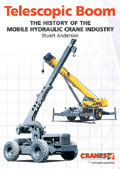 |  |
| HOOKED Crane book tells all. (Photo left courtesy of Historical Construction Equipment Association) | |
Crane technology started to evolve substantially during the rough-and-ready post-war buildup in 1945-1955, when need for speed forced the development of hydraulic power transmission. New controls made the machines quieter, smoother, faster and safer in the hands of operators.
The industrys adoption of hydraulic cylinders has replaced clutches and cables on many thousands of cranes and excavators. The telescopic boom hoisted once-underfunded manufacturers to the top, while many diversified company giants lost their edge and fell into the junk yards of construction lore.
Longtime crane guru Stuart Anderson is a likely champion to tell the epic tale in a new 240-page, full-color book Telescopic Boom: The History of the Mobile Hydraulic Crane Industry (Wilmington Publishing, $130). The hard-to-find book is available through the Internet at www.connectingcranes.com.
Anderson brings a 23-year career in the manufacturing business, having served in executive roles at Coles Cranes in the U.K. and U.S.-based Grove Manufacturing, which bought out Coles years before its own sale to Manitowoc Crane Grouppreviously of lattice-boom fame. Anderson now is president of Chortsey Barr Associates, Hagerstown, Md., where he has worked as a market analyst for 14 years.
The author recounts a 175-year history of mobile crane technology, from steam to diesel power and wire cable to hydraulic pump. Featured is an all-star cast of innovators like William S. Otis, Capt. Richard Thew, Ed Drott, Ray Pitman, Hans Liebherr and John L. Grove. Andersons prose reads with the dramatic flair of a skilled business journalist, though frequent typos clutter up an otherwise clean story.
Anderson explains major crane categories, including the little-known tractor crane of Australia. He also pinpoints the first automatically telescoping crane, which Austin-Western built for WWII Seabees. Pacific soldiers who used the cranes snub nose to handle bombs aptly nicknamed it the Anteater (see photo).
Anderson throttles well beyond machinery milestones and beauty shots. Regrettably, the book lacks a reference index, but its detailed account tracks hundreds of manufacturers around the world, with thorough time lines and charts.

Post a comment to this article
Report Abusive Comment